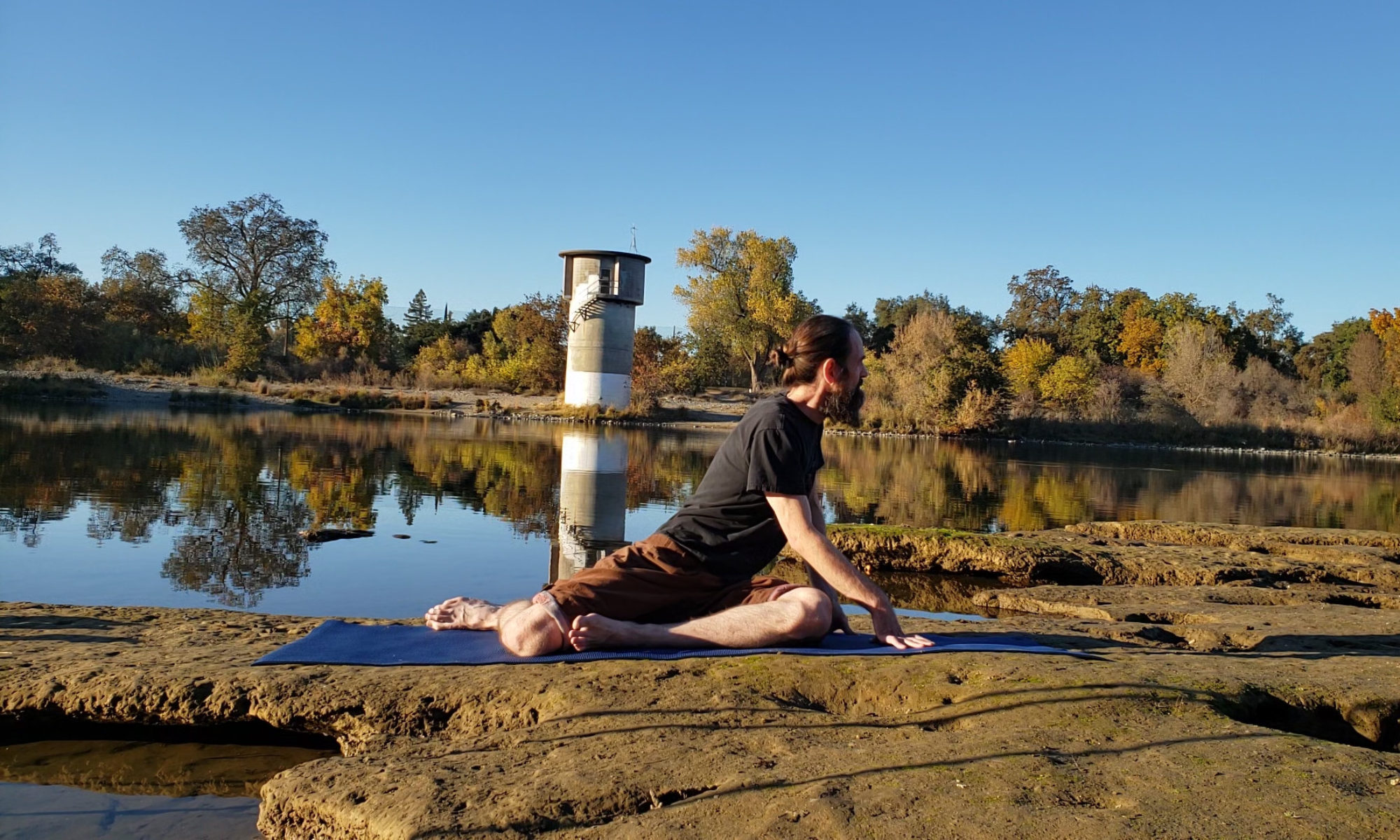This is a stretch sequence that helps to relieve tension in the legs and spine. The sequence involves slowly transitioning from a standing position to a forward folded position.
Sequence Steps
- Enter the initial position for the sequence:
- Stand upright with your knees straight, feet a little wider than hip-width, and arms loosely hanging at your sides.
- Imagine the back of the top of your head were suspended by a string and your shoulders are hanging loosely back and low.
- Balance your body evenly over your feet, both right to left and front to back. Most of your weight should be on the front of your heels, but make sure the balls of your feet take a small part of the weight as well. Shift your weight slightly left and right, then forward and back, being mindful of how being slightly off-balance in each direction feels in your body. Return to the balance point that feels the most centered, grounded, and requires the least muscle engagement to maintain.
- Take a deep breath. When you exhale, focus on the back of your head maintaining its current position, but every other muscle releasing as much as possible.
- Picture yourself folding over at the waist with knees straight and your hands touching the floor. Mentally assure yourself that:
- A body free of tension will feel relaxed in the legs and spine in all positions between the initial position and the fully folded-over position.
- The cause of any position in between these feeling any tightness is muscle tension, not just engagement.
- Slowly fold down to the floor
- Very slowly begin folding over by positioning your chest slightly closer to your feet, just enough so that you can tell that you have moved. Recheck your balance, as in step 1a. Imagine that you need to keep your chest at this position for several minutes. Find the most comfortable body position possible while maintaining this chest position.
- Keep slowly moving your chest a little closer to your feet, pausing frequently to perform a microstretch. This means: check your balance and relax your body as much as possible for each given position. As your lean further over, allow your hands and head to gently drape downward. Make sure to release your shoulders and neck as their weight begins to hang downward.
- Relax at the bottom
- When you reach the bottom of your range of motion in this sequence, unless you are already extremely flexible, the weight of your upper body will be supported by the tightness of your posterior chain muscles. Don’t use any force, apart from gravity, to push any closer if you can’t reach the floor at this point.
- If your hands, or at least fingers, reach the floor with only the force of gravity, use them to take some of the weight off your posterior chain by pushing them lightly into the floor. Alternately, grab your ankles, shins, or knees and use them to support some of your weight.
- Slowly roll back up to the top
- Begin by gradually transferring weight from your hands back to your feet so that you can release your hands gently without a sudden weight shift to your feet.
- Reverse the fold by slowly raising your chest further from your feet. Take frequent pauses to make sure each position is as relaxed as possible. Feel each vertebra come into position one at a time as they roll-up. Pay special attention to gently shifting your shoulder blades together when your upper back begins to straighten. Make sure the neck is the last thing to roll up. As your head reaches the top, continue the unrolling up the back of your throat and into the top of the back of your head.
- Repeat the folding/unrolling motion and microstretches for as long as microreleases are sensed and time permits. Microreleases are tiny releases of muscle tension which may be perceived as pops, cracks, tingles, foreign-feeling muscle sensations or movement, choppy motion, and/or temperature changes.
Background
This sequence is similar to a common stretch sequence performed in yoga classes with the Uttanasana (standing forward bend) yoga pose and roll-up. The main differences in this version are the much slower speed and microstretches.
Tips:
- Keep the motion as slow as possible so that any tension that creeps in can be quickly relieved.
- Throughout the sequence, keep your center of gravity as close as possible to the natural human flat-footed balance point. When these are aligned, the strength required to keep from falling forward is equal to the strength required to keep from falling backward. The natural human flat-footed balance point lies at the midpoint between the fronts of the heels. As you bend further forward, feel how your upper body weight pulls you slightly forward, putting more weight onto the balls of your feet. This pulls your body off balance, causing your ankle and shin muscles to engage to keep you from falling forward. Correct this by using your feet to shift your weight slightly backward, returning the majority of the weight to the front of your heels. Feel how this allows your ankles and shins to relax. Visualize your perceived center of gravity as a dot on the floor. Keep moving this dot back to the natural balance point.
- Don’t worry about positioning your spine, head, or hips as you fold. Your body knows how to position them correctly when you focus on the positions of your center of gravity and chest while keeping your overall body tension as low as possible.
- You will likely find certain muscles in your legs or spine start to tighten up at different points of the fold. They may suddenly feel like they are carrying a heavy load and getting tired. There are lots of muscles between your chest and your feet that can handle parts of the burden of maintaining your body position and balance. If one muscle feels fatigued, redistribute the workload to adjacent muscles by releasing, or partially releasing, the tight muscles, but maintaining the chest-to-feet positioning. If the fatigue is still too much, allow your chest position to fall a bit so that the load falls on different muscles.
- Don’t rush down to the bottom of the fold, as is typical in yoga. The further down you fold, the more muscles in the posterior chain will reach their flexibility limit and tighten up. The faster you go down, the more likely that protector muscles will tense up and cause pain or stop you from going further down. There may still be useful stretching even when lots of these muscles have reached their limit, but the tighter this chain is, the harder it is to release tension. The most effective release of tension happens when there is only very light tension in the muscles, which will typically be near the top of the fold.
- As you get further toward the ground, tension will likely increase quicker from small drops than near the top. Compensate for this by moving smaller amounts between microstretches when tension is higher.
- If any sustained or sharp pain or muscle spasm is felt during the sequence, immediately move to a comfortable position. Remember where the pain was felt so that you can steer around the pain and move more slowly and gently near that position.
- Be extra gentle with yourself while doing this sequence. Muscles of the spine can be fragile and prone to muscle spasms. Gentleness also helps increase the tension release rate while preventing injury.
- Try this sequence in a completely silent place if you can find one or with earplugs. Microreleases during this stretch often make audible sounds like pops, clicks, and cracks even in very light levels of tension. Many of these will be very low volume and only audible to you, as the sounds travel better through your bones, muscles, and tendons to the eardrums better than through the air. Focus on these sounds of muscle release to help you understand how even extremely gentle movements can release tension.
- There are lots of variations of this sequence possible by using different focal points. Try doing it while gently sucking in your abdominal muscles for the entire motion. You can also do it with the shoulders in all four positions: low-back, low-front, high-back, and high-front.
- At different points in the sequence, try pressing in different parts of the feet into the ground like you are squishing a bug. Press the big toes down for a while, then relax them and return to the balanced position. Press a side of your heel, the middle of the feet, etc. This helps to engage underactive muscles that may interfere with reaching a lower, more relaxed position.

